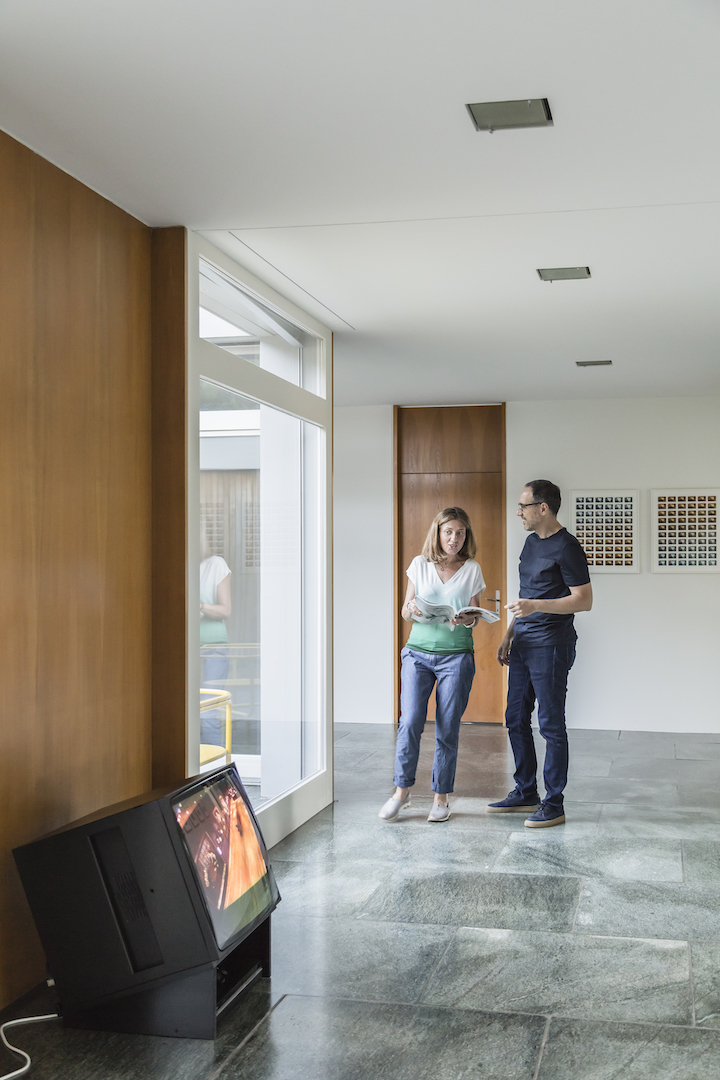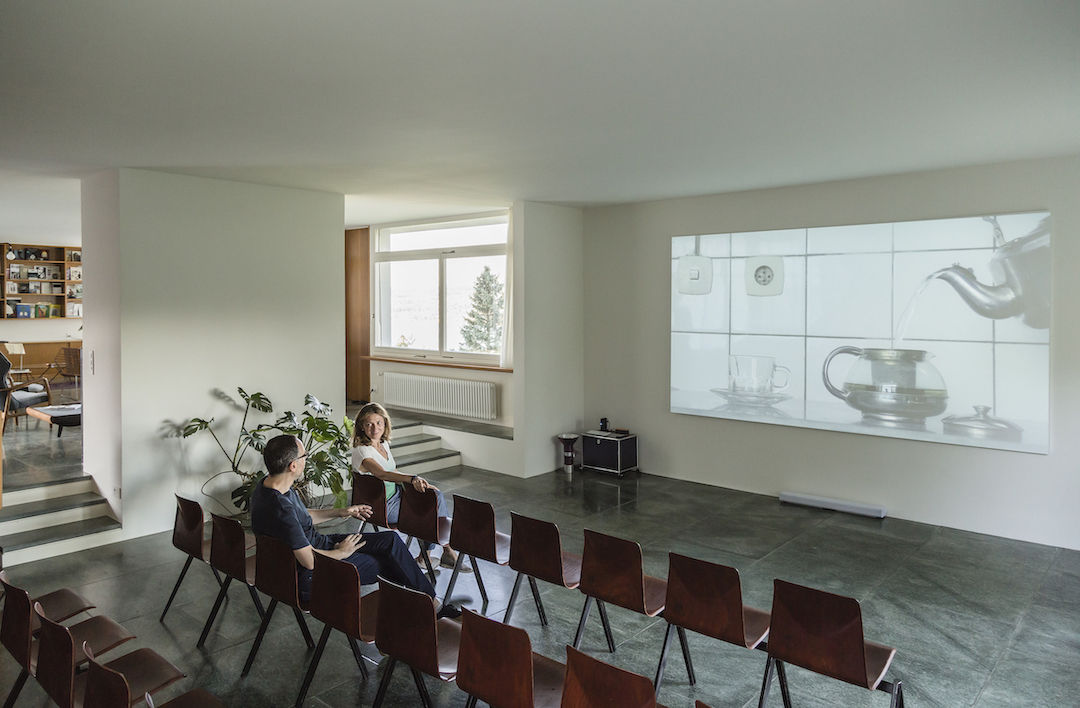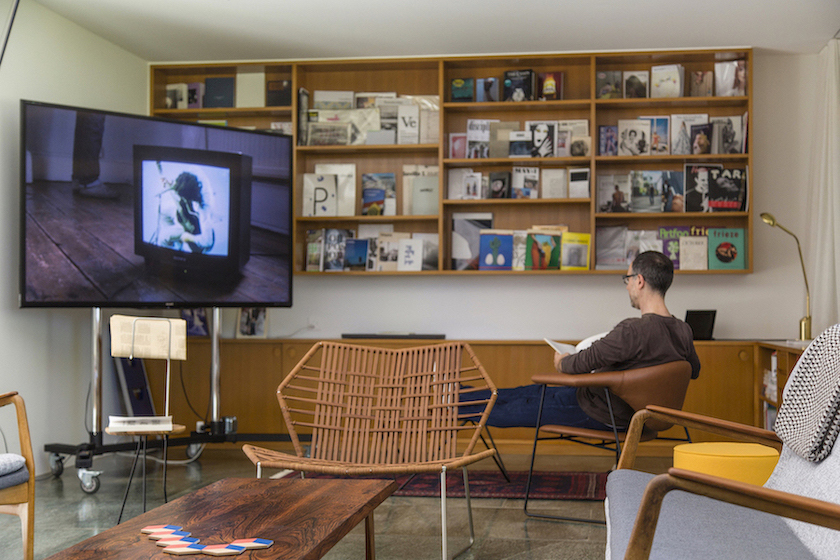Haro Cumbusyan and his wife Bilge Ogut have been collecting contemporary media art for two decades. Haro Cumbusyan is the Founding Director of EK BİÇ YE İÇ, a social enterprise based in Istanbul that explores strategies for a healthy, enjoyable, and sustainable life in big cities. Before that, Haro ran collectorspace, a nonprofit organization that aimed to study art collecting practices by opening up private collections to public view and subjecting them to critical review. Haro is a member of the Board of Directors of Council (Paris), SAHA (Istanbul), and Centre d’Art Contemporain (Geneva), the Board of Advisors of Protocinema (Istanbul/New York), the Selection Committee of LOOP Moving Image Fair (Barcelona), and the Acquisition Committee of Media and Performance at MoMA (New York).
As we wonder how he has the time to be deeply engaged in so many activities in various art and cultural organisations, LARRY’S LIST had a conversation with this inspiring guest speaker at The Digital Art Collector Summit last week. Haro explained his great interest in both media art and the topic of ethical collecting, and what he thinks the model is for next-generation cultural institutions. He also shared with us his mind-opening experience in art and how he proposed to his wife in the Whitney Museum. Last but not least, for artists, architects or interior designers, don’t miss out the last part — Haro might need your ideas.

What made you want to start collecting art? What is the main motivation behind your collecting?
Often the history is written after the war is won. But in our case, our approach were quite deliberate and public from the get-go (even if a bit peculiar…) My wife, Bilge, and I found our engagement with contemporary art to be very fulfilling, but we both had insanely busy work schedules. We thought having some skin in the game would force us to make time to visit exhibitions and to research artists’ practices (more like what we were used to doing for work); so we decided to start collecting.
It wouldn’t be a gross exaggeration if I said that my world view has changed almost entirely because of our involvement with contemporary art. I considered myself socially pretty liberal when we started the journey. It took me at least 10 years to realize that I was actually a privileged white male with almost all the entitlements that come with the neoliberal capitalist system. In the following years, I started focusing a little less on collecting, and more on enabling the production and circulation of art. But we still acquire works because we believe that’s a reasonably good way of supporting the art ecosystem.
Why are you particularly interested in media art? Is there a theme that unites all the works you have collected?
Bilge grew up watching films from behind the Iron Curtain, and I was addicted to music videos in my younger years. We were both close to technology — she was a venture investor, and I had an engineering degree. Plus, I was working in a strategy consulting shop, so I had to come up with a strategy for our collecting… As our resources were limited to compete with established collectors on traditional top-quality artworks, we decided to focus on an area we had an advantage on: technology-enabled art. We were both passioned about the moving image; and coincidentally, video was (and still is) being referred to as time-based art — as time was our most scarce and precious recourse, collecting art that utilized it as a critical dimension, and demanded it to be appreciated, was simply irresistible to us. Of course, beyond all this, it was clear to us that much of the relevant art of our era was going to be produced in this medium that allowed artists so many more ways of expressing their ideas. That sealed our decision to collect what we now call media art.
The concept of time has certainly left its stamp on our collection. But we’re always drawn to works that challenge our (mis-)perceptions about the world, unearth an issue that we haven’t been aware of, or connect dots to reveal a new pattern that we haven’t seen before. So, there’s no particular theme or style that we pursue. Obviously, we get excited when a new work brings a different perspective to a narrative that we had pieced together with a group of previous acquisitions.
Where do you display your collection?
We own quite a few screens…
Have you ever presented your art collection publicly?
We love hosting screenings/collection visits at home — hope that we’ll get back to those days soon. We’re always open to giving the artworks a chance to meet a wider audience; after all, artworks are made to be seen… In 2015, we had a very enjoyable collaboration with two dear friends and great collectors from Istanbul, Saruhan Doğan and Agah Uğur, where we presented our collections jointly (and without individual attribution) at SALT Beyoğlu in two installments. The show conceived by legendary Vasıf Kortun and curated by November Paynter was titled Every Inclusion is an Exclusion of Other Possibilities—a phrase that I still refer to often…
How important is it for you to meet or even engage with the artists who created the artwork?
Meeting the artist isn’t that important to me personally unless we’ll have a meaningful interaction. Maybe the biggest privilege of collecting is getting a chance to spend time with artists. Normally, we look at the work that the artist has created, and try to infer what they had in mind. Instead, having direct access to the mind of the creator is priceless…

What motivated you to found collectorspace?
We didn’t graduate from collecting school. Fortunately, when we were living in NYC, we had the opportunity of visiting many private collections—that was an invaluable education for us. We listened to established collectors talk about why they collect, and how they go about it. We saw many inspiring displays of artworks in living rooms and bedrooms, and some that were maybe a bit questionable. Two issues became very clear to us: (1) There’s amazing quality and quantity of art in private hands that is awaiting to be seen by the public; and (2) collecting art is a quite serious endeavor that comes with great deal of responsibility, but lacks a critical review mechanism for healthy development. collectorspace was a nonprofit initiative that I ran with a very talented curator, Özge Ersoy, that aimed to (i) open up private collections to public view, (ii) offer some objective feedback to collectors invited to the program, and (iii) provide local collectors a variety of reference points about collecting from around the world.
Bilge and I got to meet some amazing collectors through this initiative. One pattern that we observed was that many of them — especially the ones who we thought had the most enviable collections — were talking about their interactions with the artists more than the artworks in their collection. Thought I’d mention as a follow-up to your previous question…
You are also very interested in the topic of ethical collecting. Can you tell us more about that?
Collectors play an (almost) indispensable role in the art ecosystem. When they make better choices, we can expect the whole ecosystem to flourish. This, first and foremost, involves financing the production of artworks that serve intellectual growth and social wellbeing. More than that, “making better choices” also calls for ethical behavior towards the artworks, the artists and their representatives, as well as towards institutions that collect and/or show art. Sadly, the artworld is fraught with market manipulation, speculation, money laundering, artwashing, tax evasion, and other not-so-ethical behavior that limit its potential as a source for intellectual and social progress.
“Can collecting be ever ethical?” asked Andrea Bellini, the brilliant Director of Centre d’Art Contamporain Genève, when I approached him for some guidance recently. Surely, that was a rhetorical question… Last year, a Paris-and-Athens-based collector and ethics professional, Piergiorgio Pepe, and his collecting partner, Iordanis Kerenidis, started an initiative to develop ethical guidelines for collectors. I’ve been participating in the monthly working sessions they’ve been organizing with a small advisory group to come up with an initial draft that should serve to open up a wider discussion on the topic. I think Larry’s List would be a fantastic platform to get feedback, and expand the breadth and depth of this conversation.

You also support the work of non-profit organizations, such as Council, and their project AFIELD. How is the experience? And what is the vision in contemporary art that you share with the organization you work with?
Ideas and knowledge become more valuable as they cross borders because when they do, more people can use them, contribute to them, push them forward. Projects that enable ideas and knowledge to cross borders, whether geographical or across disciplines, are of interest to me.
Council, the brainchild of Sandra Terdjman, co-founder of Kadist, and Grégory Castéra, the soft-spoken curator, educator, and expert on collective practices, is in my mind a model for next generation of cultural institutions. It engages in long-term projects on critical issues of our time, brings together practitioners from different disciplines to collaborate on creative responses, and presents the outputs in different formats and in various locations around the world. It often partners with other institutions as it doesn’t have a fixed exhibition space it’s bound to. The footprint is small, but its impact is potentially quite large…
AFIELD is a fellowship program that Council is running. I was involved in the selection process of the AFIELD fellows for the first time last year; and I was truly humbled by the extraordinary commitment of the applicants to create positive change in their local communities through art. I get to participate in monthly Kitchen Calls where participants from far corners of the world, presumably working under quite different circumstances to bring about social, environmental, or political change, learn from and support each other. It’s a very mind-opening experience for me.
I encountered an artist collective called Something & Son with a community-building practice in London several years ago. After the Gezi Protests in Istanbul, the collectorspace project lost its urgency in my mind a little, and showing art in our public-facing space near Taksim Square became subject to (self-)censorship. So instead, I invited Something & Son to start a project together exploring ways of creating a healthy, enjoyable, and sustainable life in big cities. We decided to focus on food as the major factor that affects all aspects of our mission; and set up a social enterprise we called EK BİÇ YE İÇ [plant-harvest-eat-drink] that builds urban farms around the city, runs healthy food eateries, and offers workshops on sustainable living. After about six years, this project still takes most of my time and energy; but again, I find the collective effort very nourishing.
Another institution I’m very happy to be a part of is Protocinema. Like Council, it also has no space of its own, yet it has a wide reach across the globe. 10 years ago, its Founding Director Mari Spirito started organizing site-aware exhibitions and cultural exchanges between New York and Istanbul; now the geographies are much more varied… In the first iteration of a multi-city group show “A Few In Many Places” (that coincided with the pandemic), Protocinema organized hyperlocal single-artist exhibitions in five cities that were tied together with an online zine (which of course could also be printed locally.) The site in Istanbul was EK BİÇ YE İÇ’s central kitchen which also has a community space that’s occasionally used for exhibitions. The location was a former bread factory; and the work installed there was a video called “Maya” [Yeast] by Burak Delier, where the memory of the yeast was being visualized with all the trauma that it presumably has witnessed over generations.
What was your happiest moment being involved in art?
I proposed to Bilge (then girlfriend/now partner) in the lobby of the Whitney Museum when it was still in the Breuer building on Madison Ave (in NYC.) This was in Spring of 2001, and we had visited “BitStreams”, which if I’m not mistaken, was the first exhibition dedicated to digital art by a major New York museum. While we were excited about the show, Bilge noticed a framed print that repeated that all-important question in a chaotic formation. Not sure if I had to kneel for her to realize that the print was not part of the show, but the clapping of the museum security staff and the visitors made it appropriately embarrassing for the occasion. It was one of many happy moments we’ve had, where art was intertwined with our life.
You are always active engaging in various projects and initiatives. What are your upcoming projects in 2021?
Somewhat connected to the anecdote of our engagement, we recently purchased a house in Princeton, NJ designed by Marcel Breuer. The interesting story about the house is that Breuer exhibited this design in MoMA’s Sculpture Garden in 1949 — in full scale! It was the first installment of an architectural exhibition series called “The House in the Museum Garden” that was responding to the post-war boom in demand for housing. (As a sidenote, I’ve to say that I find MoMA’s pioneering attitude of exhibiting, collecting, preserving all kinds of creative endeavors within art, architecture, film, technology, etc. to be awe-inspiring.) Going back to your question, during the next few months, Bilge and I will be thinking with artist and architect friends about how to restore this house in a way that’d make it become a comfortable residence in today’s standards as well as a resource for art and architecture students nearby. Any suggestions are welcomed…
Related: Haro Cumbusyan at Council
A selection of artists Haro collects:
Francis Alÿs
Haroon Mirza
Mario Garcia Torres
This interview is facilitated by Sandra Terdjman and the team at Council.
By Ricko Leung





